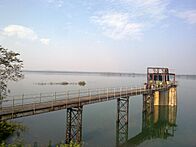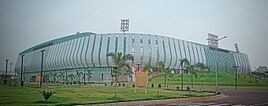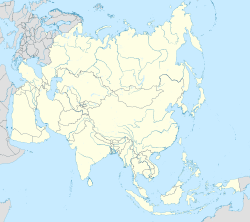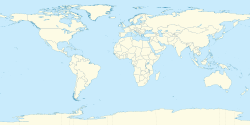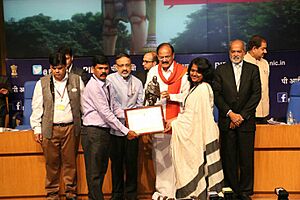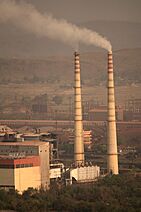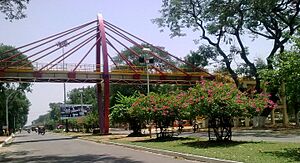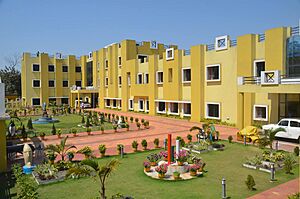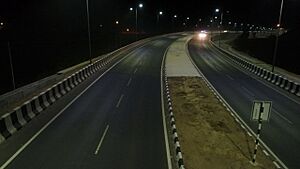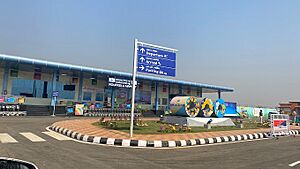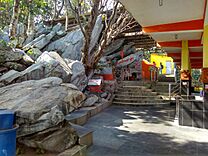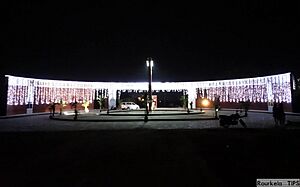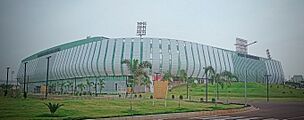Rourkela facts for kids
Quick facts for kids
Rourkela
|
|
|---|---|
|
City
|
|
|
Mandira Dam
Hanuman Vatika
Birsa Munda International Hockey Stadium
NIT Rourkela
Rourkela Steel Plant
Wide View of Rourkela
|
|
| Nickname(s):
"Steel City", "Ispat Mahanagar", "Engineering Hub", "Industrial Capital of Odisha"
|
|
| Country | |
| State | |
| District | Sundargarh |
| Established | 3 March 1954 |
| Government | |
| • Type | Municipal Corporation |
| • Body | Rourkela Municipal Corporation |
| Area | |
| • City | 150 km2 (60 sq mi) |
| Elevation | 218.23 m (715.98 ft) |
| Population
(2011)
|
|
| • City | 600,000 |
| • Rank | India 80th, Odisha 3rd |
| • Density | 6,504/km2 (16,850/sq mi) |
| • Metro | 640,750 |
| Demonym(s) | Rourkelite Rourkelia |
| Languages | |
| • Official | Odia and English |
| Time zone | UTC+5:30 (IST) |
| PIN |
769001-769xxx
|
| Telephone code | 0661 |
| Vehicle registration | OD-14 |
| UN/LOCODE | IN RRK |
Rourkela is a planned city in the northern part of Odisha, India. It is the third-largest city area in Odisha. Rourkela is about 328 kilometers west of Bhubaneswar, the state capital. It is surrounded by hills and rivers like Koel, Sankha, and Brahmani.
People often call Rourkela the Steel City of Odisha or Ispat Nagar. This is because it has one of India's largest steel plants, the Rourkela Steel Plant, built with help from Germany. The city also has a top national technical school, NIT Rourkela. Every year, Rourkela Day is celebrated on March 3rd.
Rourkela was chosen as a "smart city" in 2016. This means it aims to grow economically and improve life for its people. It has also been named India's Fastest Moving City in its size category for the East Zone.
Contents
History of Rourkela
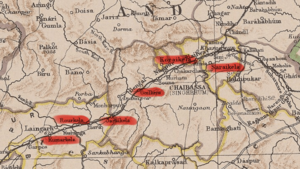
The name Rourkela comes from the local Sadri language. It means "Your Village" (Rour means "Your" and Kela comes from "Kila" meaning "Village"). Rourkela is part of the Sundargarh district in Odisha.
Long ago, the area where Rourkela now stands was covered in thick forests. Kings used to hunt here. In 2011, Rourkela had a population of about 483,038 people.
India's first public steel plant was built in Rourkela. German companies, Krupp and Demag, helped set it up. In the 1950s and 1960s, Rourkela was the biggest German community outside of Germany.
Before the steel plant, there was a village called Durgapur. The hills nearby were known as Durgapur Pahada. Today, this area is called Uditnagar.
After India became independent, the first Prime Minister, Pandit Jawaharlal Nehru, wanted to make India an industrial country. Sri Biju Patnaik suggested Rourkela as a good place for a steel plant. Rourkela had many minerals and was located near the Brahmani, Koel, and Sankha rivers.
Work on the steel plant started in 1952. The government bought about 80 square miles of land around Rourkela for the plant. German companies, Krupp and Demag, provided money and technical help. Krupp used its experience from its own factories in Germany to build the Rourkela Steel Plant.
More land was needed for the plant, a dam, and railway lines. This meant that many people had to move from their homes. About 13,000 people from 2,424 families were relocated. Many of these people were given jobs and new homes.
Thousands of German experts came to Rourkela to help with the steel plant. They formed a club called the 'Indo-German Club' to socialize. This club still exists today and has a library. Many local stories are told about the Germans meeting the local people and workers from other parts of India.
Geography of Rourkela
Rourkela is located in the Sundargarh district of Odisha. It is about 219 meters above sea level. The city covers an area of about 200 square kilometers. Being on the main railway line between Howrah and Mumbai was a big advantage for setting up the steel plant here.
The soil in Rourkela is red and laterite, which is rich in minerals. The area is also rich in iron-ore, which is why the steel plant was built here. Bolani and Barsuan are important mines nearby. Rourkela is a hilly area. A small hill range called Durgapur Pahad runs through the city, dividing it into the plant area and the steel township.
The South Koel River and Sankha River meet at a place called Vedvyas in Rourkela. From there, they flow together as one river, the Brahmani.
City Layout
Rourkela city is divided into two main parts: the Steel Township and the Civil Township. The Steel Township has residential areas for employees of the Rourkela Steel Plant. It is known for its green spaces and beautiful monuments made of steel.
The Civil Township is the other part of the city. There is also a smaller area called Fertiliser Township, which is now known as Sector-22.
A 16-kilometer long Ring Road connects the different parts of the steel city. This includes areas like Chhend Colony, Civil Township, Udit Nagar, and others.
Climate
Rourkela has a tropical climate. It gets a lot of rain during the monsoon seasons, from June to September and again from December to January. The average yearly rainfall is between 160 and 200 centimeters.
Temperatures can range from 5°C in winter to nearly 50°C in summer. The area has semi-evergreen or tropical dry deciduous forests. Rourkela has been ranked as the 12th best "National Clean Air City" in India for cities with 3-10 lakh population.
| Climate data for Rourkela, Odisha | |||||||||||||
|---|---|---|---|---|---|---|---|---|---|---|---|---|---|
| Month | Jan | Feb | Mar | Apr | May | Jun | Jul | Aug | Sep | Oct | Nov | Dec | Year |
| Mean daily maximum °C (°F) | 27.0 (80.6) |
29.6 (85.3) |
34.9 (94.8) |
39.3 (102.7) |
41.4 (106.5) |
37.2 (99.0) |
31.3 (88.3) |
31.1 (88.0) |
31.5 (88.7) |
31.1 (88.0) |
28.6 (83.5) |
26.8 (80.2) |
32.5 (90.5) |
| Mean daily minimum °C (°F) | 8.2 (46.8) |
14.4 (57.9) |
18.9 (66.0) |
23.7 (74.7) |
27.0 (80.6) |
26.8 (80.2) |
25.0 (77.0) |
24.9 (76.8) |
24.6 (76.3) |
21.5 (70.7) |
12.4 (54.3) |
6.0 (42.8) |
19.5 (67.0) |
| Average rainfall mm (inches) | 13 (0.5) |
20 (0.8) |
19 (0.7) |
15 (0.6) |
40 (1.6) |
221 (8.7) |
416 (16.4) |
419 (16.5) |
218 (8.6) |
56 (2.2) |
8 (0.3) |
3 (0.1) |
1,448 (57) |
| Source: en.climate-data.org | |||||||||||||
Economy and Industries
Rourkela is known as the industrial capital of Odisha. It was the first place in India to have a large steel plant. The city has good connections by rail, road, and air. It also has many natural resources like water, land, and power. There are many skilled people here, which makes it attractive for businesses. Rourkela has never faced major natural disasters.
Since Rourkela is a "Steel City," it has many heavy industries. These include steel, sponge iron, chemicals, and cement. There are also many smaller manufacturing businesses.
- Steel Authority of India - Rourkela Steel Plant (RSP)
- NTPC-SAIL Power Company Limited, (NSPCL) Rourkela
- OCL India Limited in Rajgangpur
- Larsen & Toubro Fabrication Plant in Kansbahal
- Kalunga Industrial Estate
- Bondamunda-Rourkela Locomotive Shed (Indian Railway)
- Software Technology Parks of India (STPI), Rourkela
City Management
The city is managed by different groups. The Steel Township is looked after by the Steel Plant Administration. Other parts of the city are managed by the Rourkela Municipal Corporation. Some rural areas are managed by the Jalda Panchayat.
- Rourkela Municipal Corporation: This group manages the city and takes care of public services and infrastructure. It became a Municipal Corporation in 2014.
- Rourkela Development Authority: This was created in 1995. Its goal is to build housing, shopping centers, and industrial areas. It also works to improve slums and develop the city in a planned way.
- Rourkela Smart City Limited: Rourkela was chosen as a smart city in 2016. This project aims to provide basic services, improve quality of life, and use "smart solutions" for the city.
Population and People
| Religions in Rourkela City (2011) | ||||
|---|---|---|---|---|
| Religion | Percent | |||
| Hinduism | 82.0% | |||
| Islam | 8.11% | |||
| Christianity | 7.36% | |||
| Others* | 2.53% | |||
| *Others include Buddhists, Jains and Sikhs | ||||
As of 2011[update] Rourkela Metropolitan Area had a population of 536,450 people. About 54% of the population are males and 46% are females.
Rourkela has a high literacy rate of 75%. This is higher than the national average. About 81% of males and 69% of females can read and write. About 12% of the population is under 6 years old.
| Historical population | ||
|---|---|---|
| Year | Pop. | ±% |
| 1971 | 47,076 | — |
| 1981 | 96,000 | +103.9% |
| 1991 | 152,690 | +59.1% |
| 2001 | 259,553 | +70.0% |
| 2011 | — | |
| Source: Census of India | ||
- The population density is about 6,696 people per square kilometer.
- There are 835 females for every 1000 males.
- Rourkela has the highest income per person in Odisha.
- Main areas in Rourkela include Civil Township, Koelnagar, Chhend Colony, Uditnagar, and the Steel Township.
Getting Around Rourkela
Road Transportation
Many roads in Sundargarh District were built by the end of 1946. National Highway 143 (NH-143) passes through Rourkela. This highway connects Chas, Ranchi, and Rourkela. Another National Highway, NH-215, also runs nearby.
State Highway 10 (SH-10) connects Rourkela to Sambalpur. This highway was recently upgraded to a four-lane road as part of the Biju Expressway project.
The Rourkela Steel Plant manages the roads within the Steel Township. There are many daily bus services from Rourkela to other parts of Odisha and nearby states like Chhattisgarh and Jharkhand. City buses also run on different routes within Rourkela. A new bus station at Uditnagar helps with these services.
Railways
Rourkela Railway Junction is on the important Howrah-Mumbai line. It is part of the South-Eastern Railway. Other railway stations in the Sundargarh District include Bondamunda, Panposh, and Rajgangpur.
Rourkela is well connected by train to major Indian cities like Howrah, Mumbai, Delhi, Chennai, and Bangalore. It is a busy and profitable railway junction.
| Station name | Station code | Railway zone | Total platforms | Important trains |
|---|---|---|---|---|
| Rourkela Junction railway station | ROU | South Eastern Railway zone | 7 |
|
Bondamunda Loco Shed: This is a place where train engines (locomotives) are kept and maintained. It started in the 1950s for steam and diesel engines. Later, an electric engine shed was added, which now holds many electric locomotives.
Air Transportation
Rourkela Airport serves the city. It is located near Chhend Colony, about 6 kilometers west of the city center. The airport is being improved to handle regular flights.
It can handle ATR-72 type aircraft. There is space for two aircraft to park and a terminal for general aviation. The airport received its license for commercial use in January 2019. The runway is being made longer to handle bigger planes, and a new passenger terminal is being built.
Fun Things to Do and See
Rourkela has several parks for recreation. These include Indira Gandhi Park, Jubilee Park, and Ispat Nehru Park Udyaan. There is also a new Community Park in Civil Township.
Bhanja Bhaban is a center that hosts state and national level competitions for drama, fashion, and dancing.
Hanuman Vatika is a large area of about 13 acres. It has a 75-foot tall statue of Hanuman, built in 1994. There are also many temples for different gods and goddesses. People visit this place every day because it is beautiful and green.
Popular places to visit in and around Rourkela include:
- Hanuman Vatika, Civil Township
- Mandira Dam
- Vaishnodevi Temple, Rourkela (a copy of the famous Vaishnodevi Temple in Jammu and Kashmir)
For shopping, Rourkela has malls like Forum Galleria Mall, CROSSROAD Mall, Fe2 Arcade, and Plutone.
Education in Rourkela
Rourkela is an important center for education, technology, and medical research in Western Odisha. Students from all over Odisha and neighboring states come here for higher education. The city has many English medium schools that follow the CBSE and ICSE boards.
Some well-known ICSE-ISC schools are St. Paul's School, Mt. Carmel School, and St. Joseph's Convent School. CBSE schools include Deepika English Medium School and Delhi Public School. There are also government schools like Kendriya Vidyalaya and Odia medium schools.
Government Autonomous College, Panposh, is a state-run college established in 1961. Utkalmani Gopabandhu Institute of Engineering (UGIE) is a government diploma engineering institution that started in 1962.
Rourkela has a private medical college, Hi-Tech Medical College and Hospital. There are also over 15 colleges for arts, science, and commerce. These include Government Autonomous College and Rourkela Municipal College. Private engineering and management colleges like Rourkela Institute of Management Studies (RIMS) are also here.
Universities
National Institute of Technology Rourkela: NIT Rourkela is one of India's top technical schools. It was started in 1961 by India's first Prime Minister, Jawaharlal Nehru. It became an independent institute in 2002.
Biju Patnaik University of Technology: BPUT's main office is in Rourkela. It was started in 2002 by an act of the Odisha state government. Its goal is to make sure technical colleges have high-quality education and fair evaluations. BPUT also has its own campus college in Rourkela.
Sports in Rourkela
Rourkela is a big sports center with many stadiums and sports academies. It is especially famous for hockey.
Hockey
The city has two main hockey stadiums: Biju Patnaik Hockey Stadium and Ispat Stadium. The indoor stadium at Sector-20 hosts badminton and table tennis events. Many talented hockey players have come from Rourkela.
Famous Indian hockey players like Dilip Tirkey, Ignace Tirkey, and Prabodh Tirkey started their careers in Rourkela. The city has special hostels for young hockey players, helping them develop their skills.
The Birsa Munda International Hockey Stadium was built to host the 2023 Men's FIH Hockey World Cup.
Stadiums
- Birsa Munda International Hockey Stadium
- Biju Patnaik Hockey Stadium (Sector-5)
- Ispat Stadium (Sector-6)
- Biju Patnaik Indoor Stadium, Panposh
- Birsa Munda Athletic Stadium, Rourkela
Media
Rourkela has a radio station called All India Radio (A.I.R) on FM 102.6 MHz, which started in 1995. Other private radio channels include Radio 92.7 BIG FM and Choklate 104 FM. These channels play Hindi and Odia songs and host talk shows. There are also private digital media channels like Rourkela Shines that provide local news.
Festivals
Rourkela is a city where people from different backgrounds live. So, many festivals are celebrated here. These include Utkala Dibasa, Ram Navami, Pana Sankranti (Odia new year), Durga Puja, Kali Puja, Chhat Puja, Deepawali, Holi, and Christmas.
The "1st Brahmani River Festival" was held in February 2019. It showed off the rich tribal culture and heritage of Rourkela and the Sundargarh District.
Notable Residents
- Lazarus Barla — Indian hockey player
- Natraj Behera — former Odisha cricket team captain
- Samir Dash — entrepreneur
- Debasish Ghose — academic, professor at the Indian Institute of Science
- C. P. Gurnani — CEO & managing director of Tech Mahindra
- Harish Hande — Magsaysay Award winner
- Michael Kindo — Indian hockey player and Olympic medalist
- Ramendra Kumar — award-winning children's fiction writer
- Birendra Lakra — hockey player
- Rachita Mistry — Olympic athlete
- Bibhu Mohapatra — fashion designer
- Mira Nair — film director and author
- Jual Oram — current MP from Sundargarh, Chairman of Parliamentary Standing Committee on Defence and Former Union Minister for Tribal Affairs (2014–2019)
- Govinda Poddar — current Odisha cricket team captain
- Dilip Ray — MLA (Rourkela), founder of Mayfair group of hotels
- Biswapati Sarkar — writer and director
- Dilip Tirkey — former captain, Indian National Hockey Team
- Ignace Tirkey — former captain, Indian National Hockey Team
- Prabodh Tirkey — former captain, Indian National Hockey Team
- Binita Toppo — hockey player
- White Town — singer and musician
- Amish Tripathi — author
See also
 In Spanish: Rourkela para niños
In Spanish: Rourkela para niños


